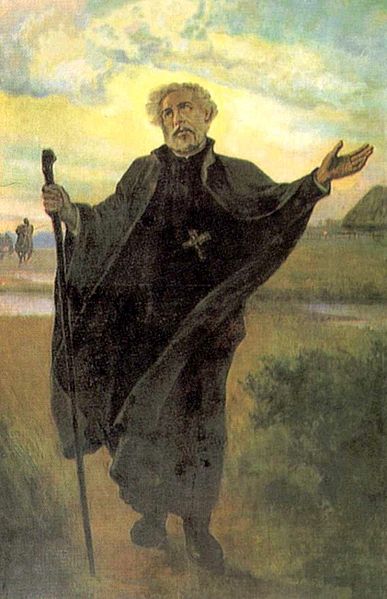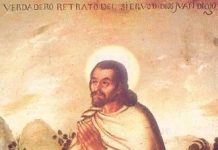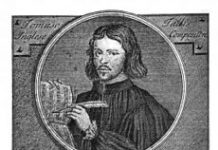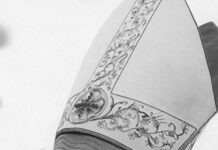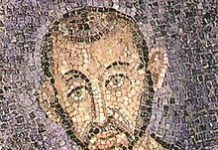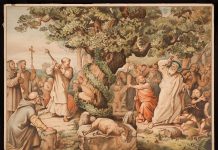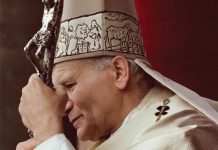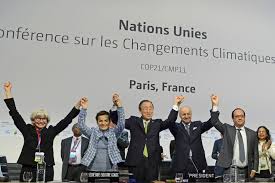(Pope Saint John Paul II had a great devotion to Saint Andrew Bobola, and venerated his relics – fitting on this twentieth anniversary of the death of the great pontiff that we meditate with Australian contributor, Paul Suski, on one of Poland’s patrons. Editor).
“On one occasion, I saw the throne of the Lamb of God and before the throne three Saints: Stanislaus Kostka, Andrew Bobola and Prince Casimir, who were interceding for Poland.” (Diary, 689)
That God has chosen St. Andrzej Bobola as Poland’s patron and protector is beyond the slightest doubt; indeed, I dedicated an entire article this subject in 2022. Yet, whom or what he is to shield Poland from remains less clear. The Green Deal, the loss of sovereignty and the unchecked influx of migrants—most likely; radical leftist ideologies striving to dismantle the Christian family model and corrupt the younger generation—without question. But perhaps there is something even more ominous?
Without exception—clergy and laity, celebrities and politicians alike—everyone dreads a global nuclear conflict. It seems to me that this darkest of scenarios is drawing ever closer to reality. Even those blessed with faith unshaken by the prospect of their own death cannot help but fear for the future of their children and grandchildren. The sword of Damocles hangs by a thread.
In March 2025, Polish Prime Minister Donald Tusk stated, “We would be safer if we had our own nuclear arsenal.” Around the same time, President Andrzej Duda urged the United States to deploy nuclear weapons in Poland, while emphasizing that the final decision ultimately lay with Donald Trump. He also recalled that in 2023, Vladimir Putin had announced the transfer of tactical nuclear weapons to Belarus.
Poland’s history is marked by domination, betrayal, and abandonment by greater powers. Even before Russia’s 2022 invasion of Ukraine, Warsaw’s trust in France, Germany, and the UK was fragile. Now, confidence in the United States has also faltered—to the extent that merely hosting American tactical nuclear weapons is no longer seen as sufficient.
Oh, let not history repeat itself as it did in 1939, when faith was placed more in military alliances and the might of the Polish arms than in Almighty God!
Miracles occurred
The countless miracles granted to individuals, families, and the entire nation bear witness to the special favour St. Andrew enjoys with God.
In 1702, as the Jesuit community in Pińsk faced grave danger, Fr. Marcin Godebski SJ, the college rector, prayed for divine aid. He experienced a vision of Andrzej Bobola, who promised protection if his remains were found and venerated. Despite extensive searching, his casket remained undiscovered until Bobola appeared again, guiding a sacristan to its exact location. Upon opening it, the body was found incorrupt, bearing fresh signs of martyrdom—widely seen as a mark of sanctity. Miraculously, Pińsk was spared both Swedish destruction and a raging epidemic, events attributed to Bobola’s intercession.
In 1920, as Poland faced the brink of annihilation, its people saw divine intervention as their only hope. As the hordes of the evil empire were at the gates of Warsaw, thousands fervently recited the novena, prostrate and kneeling in supplication before the relics of Bl. Andrzej Bobola. To this day, many devout Polish Catholics hold that the Miracle on the Vistula was brought about largely through the intercession of Our Lady of Graces, Patroness of Warsaw, and St. Andrew Bobola.
During the Warsaw Uprising of 1944, Aurelia recounts:
I had to flee my flat on Chłodna Street with my four-year-old before the Nazis began burning buildings and executing civilians. By chance, I ran into my husband on Śliska Street—we had been in separate districts since the Uprising began. We took shelter in his friend’s apartment, but from 15 August, heavy German shelling forced us into the cellar.
As we left the ruined upper floor, my husband’s foot struck something. Digging through the rubble, he pulled out an image of St. Andrew Bobola. We hung it in the cellar, our new home. On a pile of coal, we made a bed for our daughter, Danusia.
The next day, the bombardment resumed. Suddenly, an inner voice urged me: Take your child. I instinctively picked her up and stepped back. At that moment, the neighboring tenement collapsed onto our building. The spot where Danusia had just lain was buried under rubble. Only a small section of wall remained—the one where St. Andrew Bobola’s image hung.
We had witnessed a miracle. As we left, we took the image with us—our keepsake of survival. To this day, it remains with our daughter, Danuta. Now married, she named her firstborn son Andrew.
(Parish Bulletin, Sanctuary of St. Andrew Bobola, No. 9/45, 1992.)
Saint Gabriel of Our Lady of Sorrows (1838–1862) and Saint Andrew Bobola (1591–1657) lived in different eras and had no direct connection. However, in 1853, the future St. Gabriel, suffering from a severe throat illness and fearing for his life, sought the intercession of Bl. Andrew, recently beatified.
Afflicted again with acute laryngitis, Francis found himself struggling to breathe, convinced death was near. Remembering a picture of Blessed Andrew Bobola, he wrapped it around his neck and pleaded for divine aid, vowing to embrace religious life. He soon fell into a peaceful sleep and awoke miraculously cured; the inflammation had vanished. On the image of the saint, a stain appeared—seen as a sign of heavenly favour. Resolute at last, he sought admission to the Jesuits, and his request was granted.
The Blessed Relics
In a rare case of in-corruption used for establishing sainthood, St. Andrew Bobola’s corpse, despite enduring rough handling during multiple relocations, remained perfectly preserved for over 300 years. The sacred relics have traversed many resting places, yet to recount them all here would be an impossible endeavour. Thus, I shall confine myself to those instances where the hand of divine grace was most luminously manifest.
The growing veneration of the martyr, even among adherents of the Orthodox faith, unsettled the Russian authorities. In 1866, a commission was dispatched from St. Petersburg to Polotsk with the task of inspecting the relics. Yet, no sooner had they entered the chapel housing the saint’s coffin than an ominous sign befell them—a sizeable chunk of brick suddenly broke away from the ceiling, crashing down upon the imperial officials and wounding them severely. Shaken to the core, they interpreted this as a “warning” and hastily fled. Blessed Andrew was left undisturbed—until the demonic tempest of the October Revolution.
By 1917, alarmed by the religious fervour sweeping through the local populace, the authorities issued an uncompromising ban on the martyr’s veneration. A wave of frantic, anti-Bobola propaganda flooded newspapers and party meetings, whipped up to a fever pitch. The regime, seeking to justify its actions, claimed that the people themselves had demanded a “scientific” examination of the relics in order to expose the supposed “superstitious ignorance” surrounding them.
Then, in June 1922, a horde of Red Army soldiers stormed the church in Polotsk, ransacking that sacred place of everything they could lay their hands on. Shortly thereafter, a special commission from Moscow arrived, intent on scrutinizing this “Catholic fraud” with meticulous scrutiny. With brute force, the revolutionary commissars tore off the coffin’s seals, wrenched open the locks, and dragged the casket out, striking it violently against the stone floor. To their stupefaction, the body within did not crumble into dust. Baffled and frustrated, they resolved to seize it outright, whisking it away to Moscow despite fervent protests. There, it was put on display as an object of curiosity (due to its condition) in the Museum of Hygiene of the People’s Commissioners of Health.
Initially, the coffin was accessible to visitors. Upon learning of the new resting place of the relics, both Catholics and Orthodox believers began making pilgrimages, praying, and singing hymns. Arrests and beatings proved futile. Unable to suppress the ongoing miracle, the Bolsheviks, in their helplessness, relocated the coffin to a storage room inaccessible to the public.
Pope Pius XI entrusted the Papal Famine Relief Mission in Russia, led by the American Jesuit Father Edmund A. Walsh, with the task of “rescuing” the relics. In October 1923, as a form of “payment” for aid provided during the famine, the sacred relics were handed over to Walsh and his Assistant Director, Father Louis J. Gallagher, S.J. Carefully packed by the two Jesuits, they were delivered to the Holy See on All Saints’ Day (1 November 1923). In May 1924, the relics were enshrined in Rome’s Church of the Il Gesù.
Confirmed miracles contributed to the canonization of the holy martyr, Andrew Bobola, in Rome by Pope Pius XI at Easter, April 17th, 1938. The Polish people have ample reason to rejoice in the triumph of Andrew Bobola, whose name has been invoked over the past three centuries in connection with military upheavals in Poland. Thus, numerous efforts were made to bring the relics to Poland.
European Catholics had never before been so profoundly stirred in spirit as during the passage of St. Andrew Bobola’s relics from the Eternal City to Poland. Or so, at least, some commentators of the era’s Catholic newspapers professed. On 8 June 1938, to the tolling of all the bells, the relics were solemnly escorted to Rome’s Termini Station.
Dubbed the “European Retreat,” this extraordinary train’s journey through Yugoslavia, Hungary, and Czechoslovakia became a spiritual phenomenon. Along its route, throngs of the faithful congregated in uncountable multitudes, eager to pay homage to God through the almost unblemished relics of the martyr.
On 10 June 1938, just before noon, the train arrived in Budapest, the heart of Hungary, for a solemn visit to the nation’s Magyar brethren. As the military band resounded with the Hungarian and Polish anthems, an august assembly of government ministers stood in attendance. It was here that Pál Teleki, a former and future Prime Minister of Hungary, delivered a welcoming oration imbued with reverence and fraternal sentiment.
The reliquary was then carried in a grandiose three-kilometre procession to Rose Square (now Heroes’ Square), where it was placed for five hours in the Jesuit Church of St. Elizabeth. Resting upon an antique white carriage drawn by three grey horses, the sacred relics were escorted with the highest reverence. The procession was led by military and police forces clad in full-dress regalia, followed by Hungarian officials, ambassadors, the country’s church leaders, religious associations, scouts, and large number of Poles.
As it entered the Second Polish Republic, every city where the train stopped for long saw church bells tolling. Local orchestras, army honour guards, and Catholic associations with banners accompanied the relics from the station to the churches and back. Behold, millions of faithful paid homage to the holy martyr.
On Monday, 20 June 1938, in a grand procession, the sacred relics were laid to rest on Rakowiecka Street, where a sanctuary dedicated to the martyr was to be established.
St. Ursula Ledóchowska (+1942), writing about the martyr’s canonization and expressing great joy, stressed that following the saint’s example mattered more than the canonization itself. “Let the example of St. Andrew’s heroic death teach us that the path to heaven is steep and narrow.”
In the wake of the German invasion of Poland in 1939, the reliquary was moved to the Church of Our Lady of Graces in the Old Town. Later, after the outbreak of the Warsaw Uprising, it was transferred to the Dominican church on Freta Street, where it miraculously escaped destruction.
On 7 February 1945, the relics of St. Andrew returned to their rightful place—at the Jesuit Fathers’ church on Rakowiecka 61—where they remain to this day in a magnificent new basilica. The chronicles of the sanctuary record ever-new miracles wrought by God through his intercession.
Oversees news
In the Message from Most Reverend Robert J. McManus, S.T.D.
Bishop of Worcester, USA – one can read:
“I wish to inform you with great joy that, by my decision, the Diocesan Shrine of St. Andrew Bobola, Patron of Poland, will be established in the Diocese of Worcester, Massachusetts. […] His relics are also present in the Diocese of Worcester at St. Andrew’s Parish in Dudley, MA, which is the only parish in the United States where he has been the patron for 72 years.[…] The Shrine will be solemnly dedicated during the Holy Year on May 11, 2025, during the 75th-anniversary celebrations of the founding of the Diocese of Worcester.
As the Bishop of the Diocese of Worcester, I cordially invite you, my dear Parish Priests, and the faithful of your parish communities to pray for the future of this Shrine and to participate in its dedication to the best of your ability. A Novena to St. Andrew Bobola will be led by His Excellency Bishop Piotr Turzyński, delegate of the Polish Episcopate, from May 2 to 10, 2025.
We commend you, my brother priests, to our prayers and entrust you to the care of St. Andrew Bobola, so that he may intercede for you and obtain blessings from God.”
Fr. Krzysztof Korcz, the parish priest of St. Andrew’s Parish in Dudley, MA, wrote:
“I received a phone call from Chicago from a man who wanted to request a Mass of thanksgiving for his wife. In February 2023, she suffered a cerebral hemorrhage, lost the ability to speak and walk, and her condition seemed dire. However, when the family began praying to St. Andrew Bobola, she regained her health. The caller also mentioned that he had a dream instructing him to request this Mass at a church dedicated to St. Andrew Bobola. When he searched online, he found our parish.
After that conversation, I began to reflect—had St. Andrew truly performed a miracle? Why did this man have a dream directing him to seek out a church dedicated to St. Andrew Bobola in the United States?
I also realized that in this parish, there had never been any formal devotion to St. Andrew—no litanies, no novenas, no indulgences celebrated on his feast day, May 16. Previous pastors had not fostered public veneration of our patron saint. Personally, I had prayed the litany of St. Andrew in private, but never with the congregation, as such a tradition did not exist here.
This deeply moved me. I understood that this phone call from Chicago was, in fact, the voice of St. Andrew himself—Begin to honor me in Dudley, and I will help you.”
In these times of the onslaught of militant atheism, Poles, at home and abroad, are called again to gather under the Cross of Christ, heeding the powerful words of Karol Baliński’s 1856 couplet: “Only under the cross, only under this sign / Poland is Poland, and a Pole is a Pole.” As Pope Pius XI reminded in 1938, “Poland must continue to be worthy of her glorious title of Defender of the Faith.”
Saint Andrew Bobola, ora pro nobis!
A postscript:
To the priests in Australia: What a great pity that in this lucky country, which boasts a considerable number of Roman Catholic churches—1,843—not a single parish priest has yet been found willing to bring the relics of St. Andrew Bobola to their land and foster his veneration.
And to the atheists, I ask—after reading this thought-provoking article, do you still dare to say, “The sooner you die, the sooner you’ll see there’s nothing waiting for you”?

